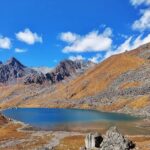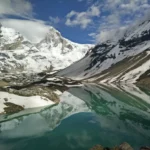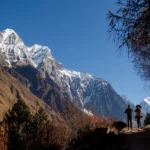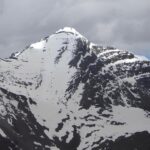The best time to visit Sandakphu Trek is during the spring and autumn seasons. Spring and autumn offer the most breathtaking views of the Kanchenjunga massif. Summer in Sandakphu welcomes you with vibrant rhododendron blooms and mighty Himalayan peaks. Autumn is another best time to visit Sandakphu offering perfect opportunities to indulge in splendid views of lofty peaks. The Autumn months of September to November are perfect for capturing radiant sunrises and sunsets.
In March and April, the trail comes alive with vibrant rhododendrons and white magnolias, painting a colourful picture. Winter arrives in Sandakphu in December and continues till February, transforming it into a snowy paradise. These months are for people who enjoy cold weather.
Sandakphu trek is not recommended during monsoon as it’s challenging to explore the trail due to incessant rainfall.
Sandakphu Trek in Spring (March – Mid-April) – Best Time For Vibrant Rhododendron Blooms
March marks the onset of the spring season and continues till April, making it an ideal time to do the Sandakphu trek. As winter snow recedes by March, the quaint villages along the trail are beautified by mesmerising blooms. The homestays and tea houses on the Sadakphu trek will have flowers blooming in unfathomable hues.
Sandakphu Trek in March
Spring season begins in March. The season witnesses unique species of flowers found on the Sandakphu trail blooming in vivid colours. The entire trail is covered with colourful wildflowers and their fragrance. You will discover beautiful flowers on your way, but red and pink Rhododendrons, along with Magnolia will dominate most of the Sandakphu trek.
Sandakphu Trek in April
Sandakphu trek in April is all about unwinding yourself in the wilderness of dense forest filled with pine, fir, and deodars. The trek remains colorful with rhododendrons blooming in pink and red in April. By mid-April occasional showers bring fog and cloudy sky. Trek to Sandakphu before April to avoid unwanted rain, also, owing to the cloudy atmosphere, some mountain peaks may not be visible during this time. However, if you want to enjoy the wonderful flora of this place, spring is the best time for the Sandakphu trek.
Sandakphu Trek in Autumn (September to November) – Recommended For Breathtaking Mountain Views
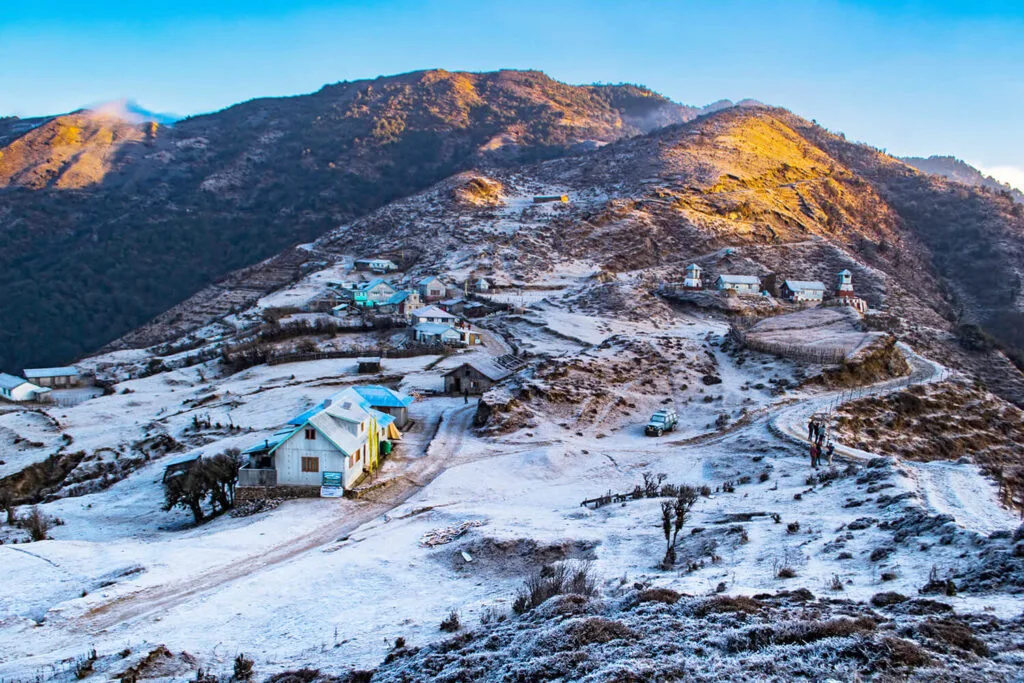
September to November is the best time to visit the Sandakphu trek for radiant sunrises and sunsets. In addition to this, autumn is the best time to capture some of the tallest mountains in the world, and the famed ‘Sleeping Buddha’ is prominently visible during these months. You will have unobstructed views of Mt Kanchenjunga Massif appearing like a Sleeping Buddha.
If you time your Sandakphu trek perfectly you will witness a lifetime view of four of the world’s tallest mountains together. The majestic peaks of Mt Everest, Makalu, Lhotse and Kanchendzonga. Do this trek between September and November, if you are passionate about calming autumn colours.
Sandakphu Trek in September
The autumn season starts in September when the monsoon departs, leaving the forest freshly washed. By mid-September, the rain wears off and the mountain views become clearer and more picturesque. The landscape reveals its true beauty with crispness in the air. If you are heading to Sandakphu in early September, be prepared for an occasional shower. To avoid the hassle caused by rain, trek to Sandakphu towards the end of September.
Sandakphu Trek in October
The Sandakphu trek in October is thronged by hundreds of trekkers and tourists who come to witness the majestic mountain views by road.
Autumn is considered best for the unobstructed views of the mountains surrounding Sandakphu. In October, you will discover a bustling trail with trekkers and tourists, as it is considered the best time for bird-watching. However, the downside is tea houses remain packed with tourists, turning in between September and October. If you want to enjoy the trek in a peaceful environment, you should visit Sandakphu in November.
Sandakphu Trek in November
Sandakphu Trek in November is less crowded due to cold winters. There is also the possibility of snowfall in Sandakphu towards November – end. November rewards you with clear views of the mountains because of the clear air and atmosphere. The landscape appears extremely beautiful as you reach higher elevations and autumn colours dominate the trail now. Sandakphu is also a rare trek where you can indulge in magical sunsets and sunrises. Trekking to Sandakphu in autumn lets you experience the sun emerging from the horizon above the clouds, a rare moment you witness on this trek.
Sandakphu Trek in Winter (December to February) – For Indulging in Frosty Winter Vibes

Sandakphu Trek in December
December welcomes trekkers with majestic views of the snow-covered mountains and the gloaming sky.
The snowfall in Sandakphu is mild and lets you enjoy the white paradise with ease. The trail remains accessible with manageable snow in winter from January to February.
Sandakphu Trek in January
Sandakphu in January receives trekkers rushing to the vantage point to ring in the new year with mountain views. You will have the leisure of winter sun if the days are clear. January is for chasing the most beautiful sunsets and sunrises you will ever witness.
Sandakphu in February
Sandakphu remains covered in snow in February as snowfall becomes frequent at higher altitudes. Trek to Sandakphu in February to witness awe-inspiring views of Himalayan peaks and soak in the beauty of nature.
Sandakphu Trek Highlights
Sandakphu Trek in West Bengal is one of the most popular trails in our country. Nestled inside Singalila National Park, this quintessential trek owes its popularity to culturally rich indulgence, the unique experience of trekking in two different countries, and the mind-boggling view of the breathtaking mountains. You will witness the famous Kanchenjunga ranges, appearing like a ‘Sleeping Buddha’ and four of the world’s highest mountains, including Everest.
Sandakphu offers a rare opportunity to experience the village along the India and Nepal border. Sandakphu is one of the few treks that can be done independently. Tea houses are available throughout the trail, allowing trekkers to attempt the trek without joining an organisation. However, hiring a guide is mandatory.
Sandakphu – Phalut trek has three different basecamps : Sepi, Jaubhari, and Shrikhola.
Sandakphu Trek is around 44 km long. If you go further to Phalut, the total distance is 65 kilometres. The trek spreads over six days, including travel to and from Siliguri, where you have the nearest railway station and the airport.

